In the previous post, Cabinet of Wonder, we visited Malplaquet House, the eccentric Renaissance-inspired London home of collectors Tim Knox and Todd Longstaffe-Gowan. In the second of five installments addressing modern day cabinets of wonder we visit the London flat of antique dealer Peter Hinwood, where English nineteenth-century-style eclecticism informs the decor and broad range of collections. Hinwood has created his own highly individualized museum of exotica in the spirit of antiquarian collectors Horace Walpole, William Beckford, Lord Leighton, Sir John Soane, and William Morris’ collections of exotic textiles and manuscripts.
Christopher Gibbs (if his name sounds familiar, he was the person responsible for designing the fireplace surround in the sarcophagus room at Malplaquet House) tells us in the article he wrote for The World of Interiors (May, 1991) that Peter Hinwood’s flat was once the drawing room in a fine London House once inhabited by the Speaker of the House of Commons, and which forty-five years ago was decorated in high style under the direction of Colefax’s Michael Raymond. Hinwood replaced the grandeur with a personal predilection for the exotic and far-flung, creating his own personal museum, or cabinet of wonder. The room, and as well, perhaps, its owner, are an enigma: without prior knowledge we could easily be in Morocco in the home of a scholar or philosopher, such as Bertrand Russell, instead of the London home of one Peter Hinwood of The Rocky Horror Picture Show fame (yes, Hinwood played Rocky). Coming from a family of collectors he went on to follow his passion for antiquities and joined forces with antiquarian Christopher Hobbs early in his career.
In the drawing room a seventeenth-century carved and painted elk head trophy above the door belonged to Elizabeth of Bohemia, the “Winter Queen”. The Turkish Harem picture to its right is from Austria, dated 1634. A Venetian mirror reflects a piece of giant marble “asparagus” from Pompeii, resting on a library table in the foreground. Green damask from Watts of Westminster covers the sofa beneath the mirror. Lively green and blue awning striped cotton from Morocco injects a colorful, casual note and tile mosaic tables from Morocco are scattered about.
Looking toward the fireplace wall, a 17th-century Venetian portrait of a mastiff hangs above a collection of antique Islamic tiles on the mantel. Alongside it is an oval-top mirror, made for the Earl of Nottingham in 1711. Simple corn-color matting foils scattered rugs and English furniture, mostly Georgian, while a constellation of Moroccan lanterns hang above.
The drawing room has since changed, naturally, since 1991. Hinwood’s flat was published again in The World of Interiors in 2008. An all-over gayer theme, likely influenced by his many forays to Morocco, was introduced: the pale pink walls were washed over in the color of verdigris; gone is the green damask sofa in favor of a prettier version slip-covered in white with a flounce skirt; the intricately etched Venetian mirror and Islamic textiles were moved elsewhere in favor of a verdant Asian landscape in the form of an eight-panel 18th-century Chinese screen, which hangs above a far simpler oval English Regency mirror and blue-and-white plates; a pastel rug replaces the warmth of the terra-cotta color rug previously in its place.
In this view the drawing room has been opened up by removing a sofa, two chairs, a library table and desk, revealing a late-seventeenth-century Persian carpet. Smaller scale grouped collections of art, some of them Indian botanical paintings mixed alongside Islamic tiles, replace the larger, darker, and heavier works of art and antiquities.
A Georgian cabinet displays a collection of Chinese blue-and-white china and Islamic tiles.
In the drawing room, on an eighteenth-century marble-topped English side table by William Bradshaw, is displayed a collection of Turkish tiles and an antique jardiniere made of Iznik fragments. Above hangs a 1913 painting by Sir John Lavery.
In a corner of the drawing room Hinwood displays a fifteenth-century brass Mamluk hammam basin on an English marble-topped table, circa 1730. Above hangs a fifteenth-century Italian “fish” portrait.
A seventeenth-century green pottery jar from Spain sits in the window before a desk displaying an album of geometrical drawings and watercolors of tile patterns throughout the Arab world. In the window hang ancient pieces of stained glass.
The small entry is painted Moroccan blue, which reads lilac. Hanging above the disguised bathroom door is a nineteenth-century Qajar portrait of a Persian beauty taking a bath. A sculpted section from a massive antique Roman urn rests on a green painted, eighteenth-century marble topped Irish table. Above it hangs an Irish white painted architectural mirror.
In the blue kitchen, previously pink, an eighteenth-century painting of a cat and lobster hangs above a picture of Moroccan child’s bird poster, surrounded by various watercolors of fruits and flowers and unusual nineteenth-century photographs.
In a view of the bedroom from The World of Interiors, May, 1991, an eclectic mix of collections and furniture suggest a pan-Arabic British Colonial locale: an 18th-century Chinese pot sits atop a glass-front English cabinet; a large African wicker basket on the floor holds and Afghan dressing gown; a Moroccan rug is laid over simple matting; an English chair is covered in Moroccan awning stripe fabric made for parasols; an 18th-century sleeping beauty by the Rev Matthew William Peters surveys the scene.
A 17th-century Persian rug hangs behind the bed. A view into the entry before it was painted Moroccan blue.
Cooking-apple-green walls form a refreshing backdrop for Hinwood’s collections, including an Irish 18th-century painting that revealed a white, not black, dog after cleaning. The English bonnet chest was bought for its ornate ormulu handles. The large 15th-century Mameluke jar was originally part of a fountain.
A mirrored wall creates the illusion of space in the bathroom. Blue-violet cabinets are inset with striped cotton and a north African bird print repeat.
A later photograph taken of the green-painted bedroom reveals a more conventional arrangement, with a centrally placed brass bed by James Shoolbred, draped at one end with a red, white and blue Ewe cloth from Ghana. Hanging above the bed is an early Asafo flag from Ghana below an African barbershop sign. Explains Hinwood, “To tell the truth, I’m much more likely to be turned on by the atmosphere of something from an African shantytown than a grand country estate.”
Next to the bed is William Hodges’s magical period painting of a tropical garden. On top of the 19th-century faux bamboo bedside table from Woburn Abbey sit an 18th-century Chinese jar and a Moroccan striped pot with lid. Striped green and red curtains from heavy cotton bought from parasol suppliers dress the windows.
The result of years of obsessive collecting and travel to exotic locales has culminated in layered rooms ripe with atmosphere that never appear or feel self-conscious. These are the kinds of spaces that allow our imaginations to soar.
In my next post we will visit the London home and studio of Peter Hone.
Content for this post supplied by The World of Interiors and Rooms to Inspire in the City by Annie Kelly.











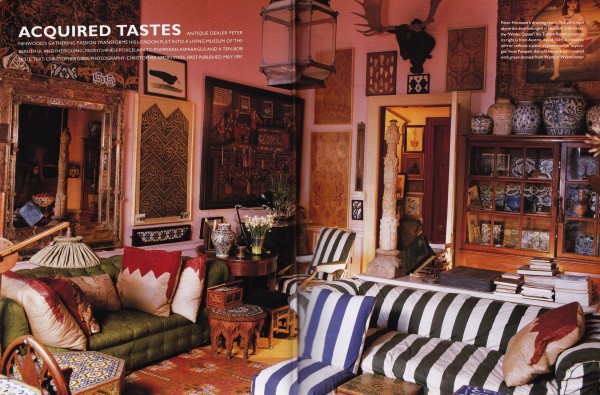
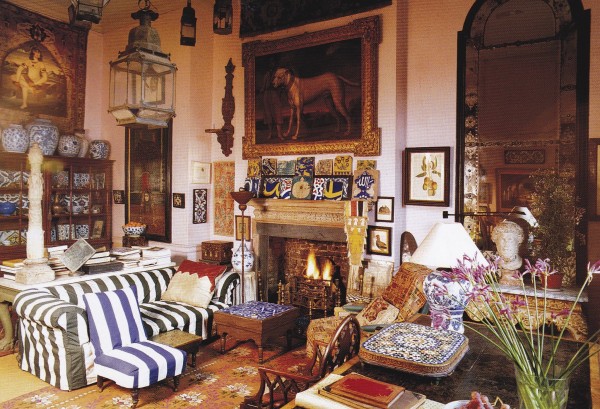
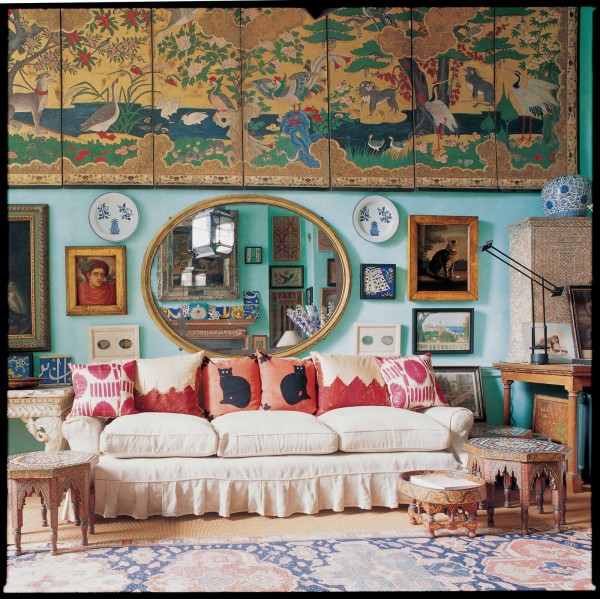
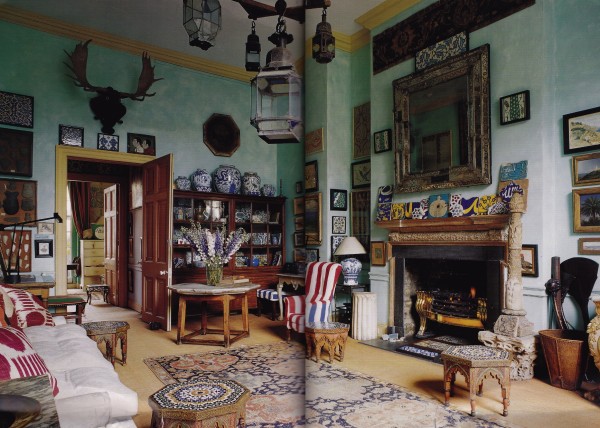
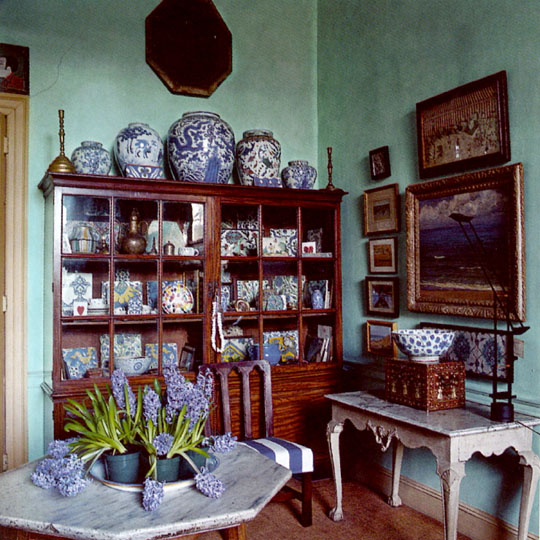
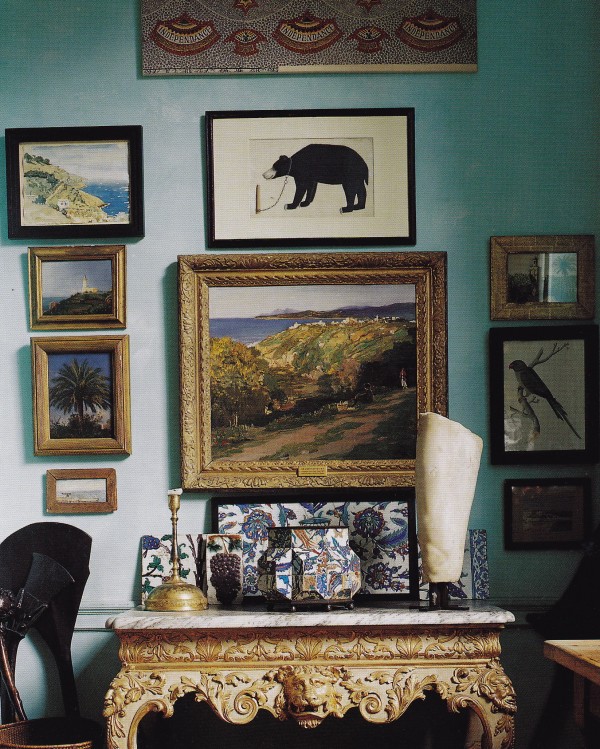
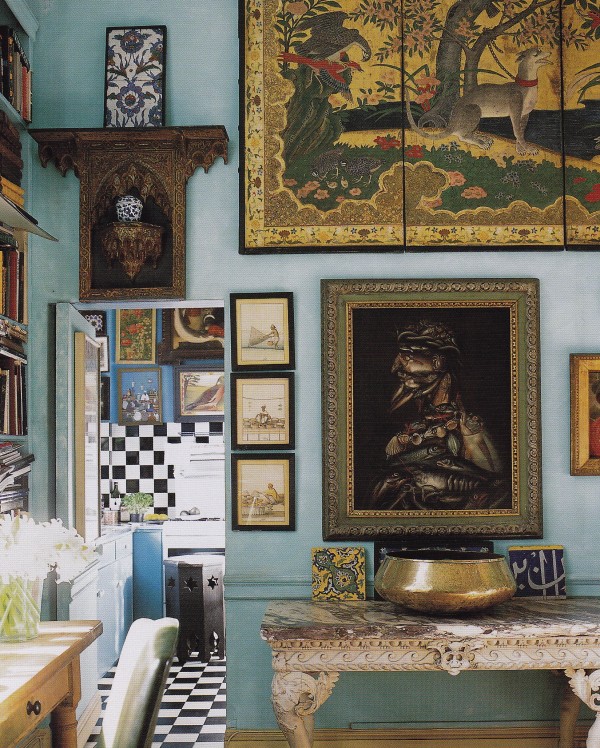
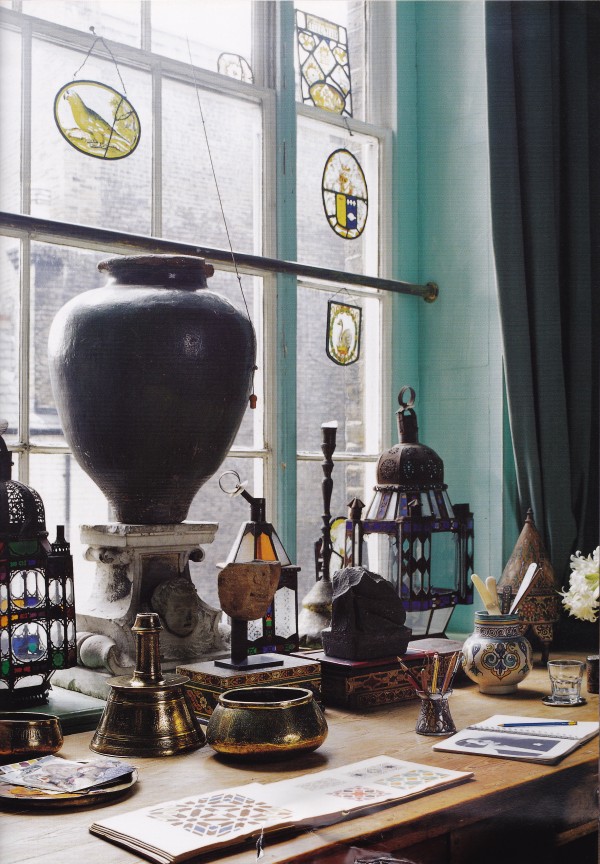
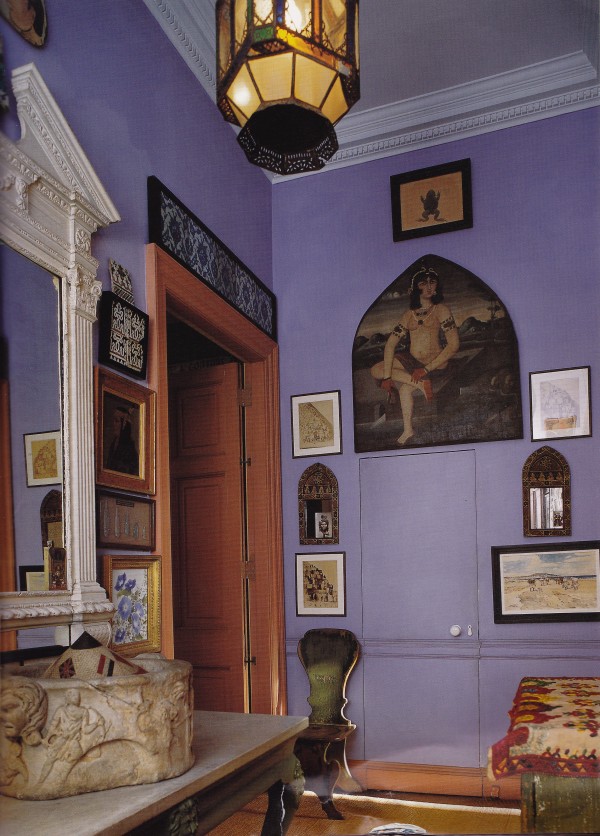
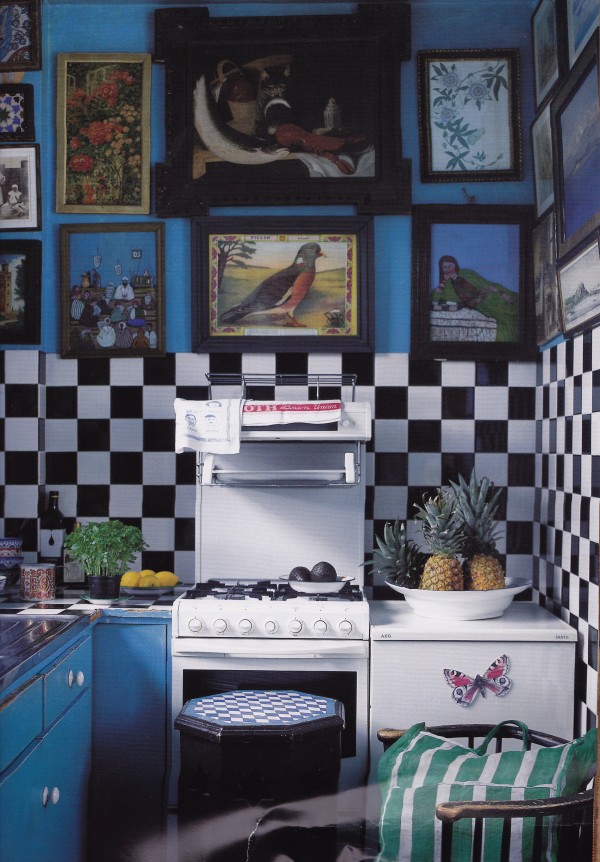
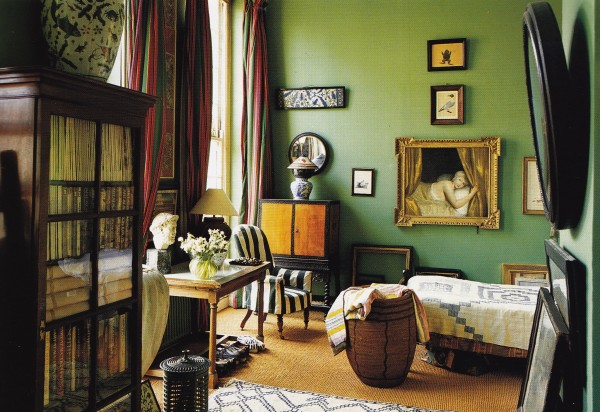
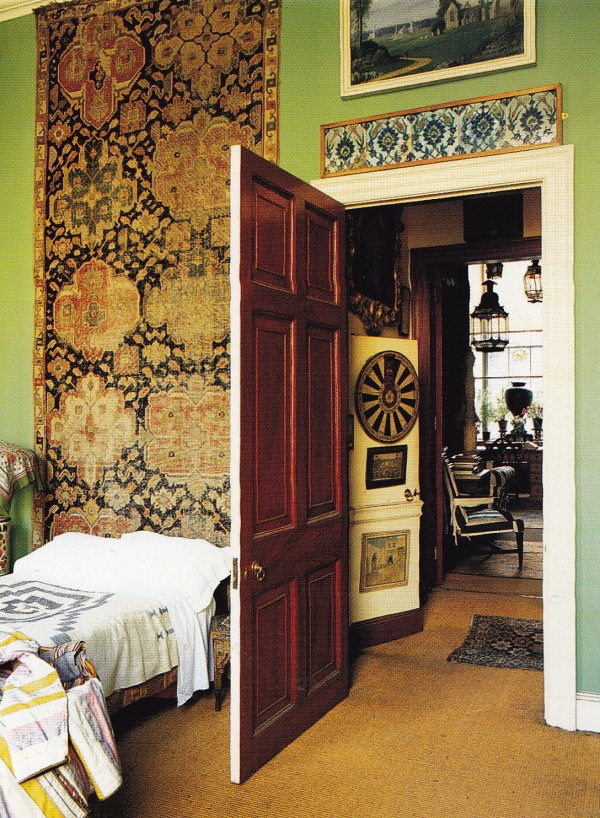
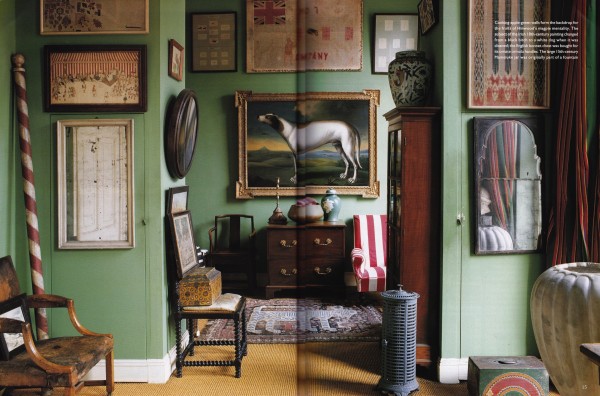
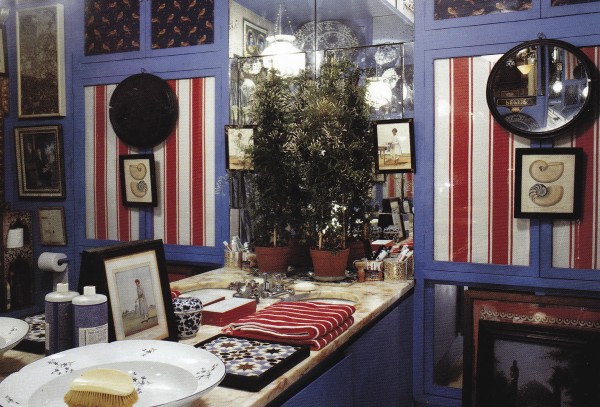
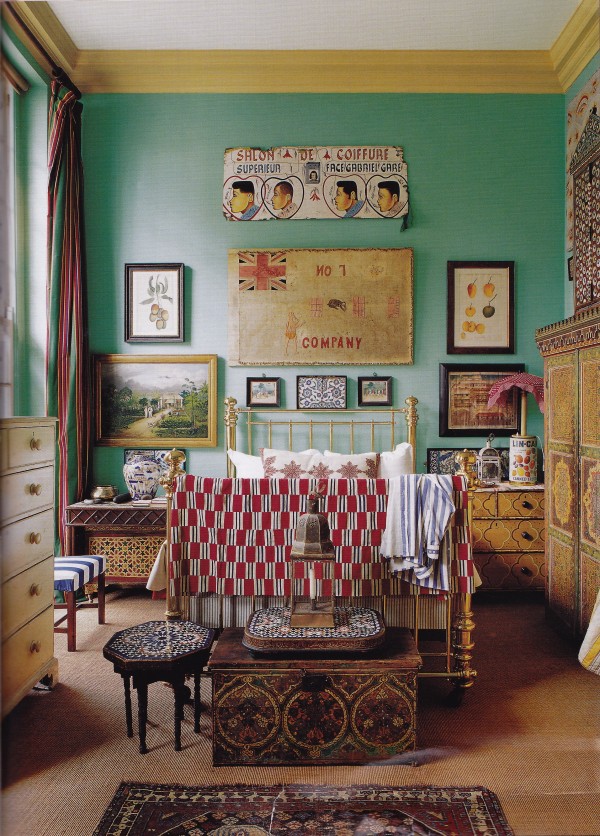
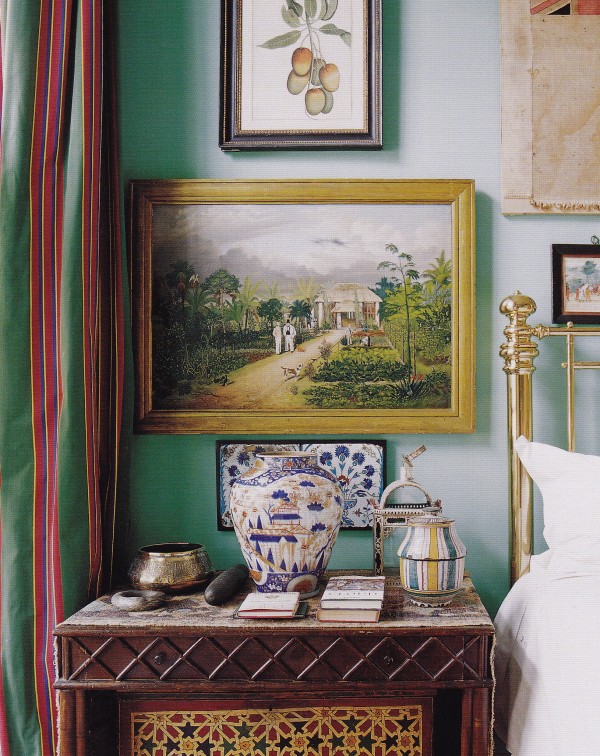



Cris……..LOVE.THIS.POST.
What a great home…with such diverse collections… this home tells stories about life… interests and fond memories. I am rather fond of that funky blue kitchen… so unique!
Victoria Silva
Thank you, Victoria, for your thought-ful insight! The tradition of the English country house and high-Bohemian style was aptly captured here in Peter Hinwood’s London flat, where rooms evolved as a result of a particular passion for collecting the exotic with a decidedly English point of view. Rooms this layered and storied speak to our soul, indeed. Don’t you want to be left behind, alone, to explore its treasures?!